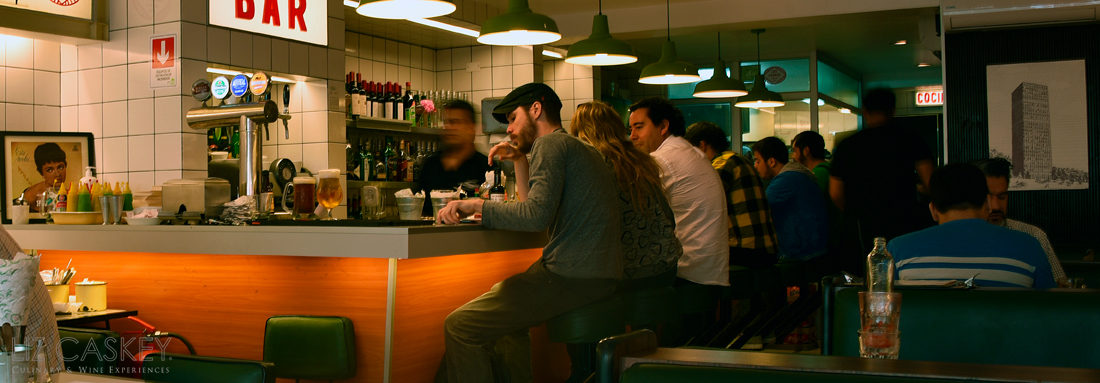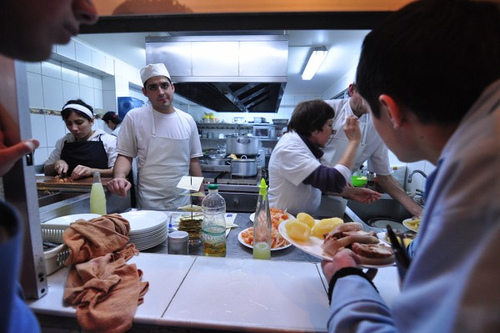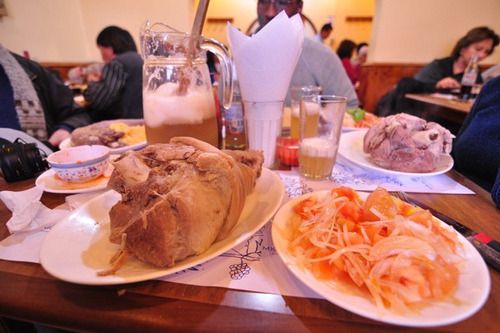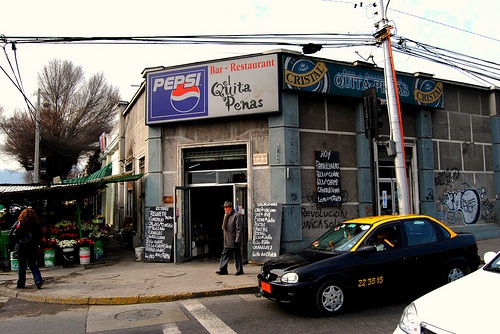Wondering what the heck is a picada? It’s simple. A joint. A simple eatery. In my humble opinion, if you want to know the soul of a cuisine, hit the joints. This is the people’s food. The kind of comfort food your grandma would make for you in the countryside. And with a lot of cariño too.
Santiago is FULL of picadas. If you want to know classic Chilean cuisine, huaso (cowboy) food, and the typical seasonal dishes that are the main stay of this culture, then by all means, pick one, or five, and dive in. Don’t forget the pisco sours, chicha, or god help you if you are adventurous, jote, table red wine mixed with Coca Cola (not joking!).
This is a small excerpt from our food & drink e-guide, Eat Wine Santiago, which by the way, both myself and the guide was just given a sweet mention in an article in UK’s main paper The Guardian on the food and cultural scene in Santiago. It was so hard to only pick five–there are SO many good picadas in this town from Peruvian to classic Chilean, seafood, sandwiches. I choose those focusing on traditional Chilean food that in the interest of better understanding what makes up Chilean gastronomy.
Bar Nacional
Huérfanos 1151, between Bandera and Morande, Santiago Centro (696 5986, www.barnacional1.cl), Metro: Plaza de Armas (green line). Open: Mon-Fri 7:30am-11pm Main Course: US$5-12 Credit: AE, DC, MC, V.
Off bustling Huérfanos, a main pedestrian walkway, and around the corner from the Pre-Colombian Museum, this Santiago classic is a favorite with locals for its homey, traditional food. As you descend the steep staircase into their basement adorned with old photos, Bar Nacional feels like a bit of a nice hole-in-the-wall. Simplicity is key here, where plates are abundant and seasonality rules. In the summertime, ask for the porotos granados con mazamorra, a creamy fresh cranberry bean stew with pureed pumpkin and corn. Their seared pork loin is juicy and delicious with palmito, (hearts of palm), avocado, and tomato salad. If you love soups, don’t miss their signature caldo de gallo, a rich chicken stock that will revive you on a cold day. Beverage-wise, skip the lethal pisco sours here and try some of Chile’s odder drink combinations like a jug of borgoña, or, for the brave, jote, red wine mixed with a coca-cola, a favorite in rural areas.
El Hoyo
San Vicente 375, corner Gorbea, (689 0339, www.elhoyo.cl), Metro: Estación Central (red line). Open: Mon-Fri 11am-11pm; Sat 11am-9pm Main Course: US$5-12 Credit: AE, DC, MC, V.
Hidden on a residential street not far from Estación Central, the central train station, this classic picada, joint, was founded in 1912 selling a few provisions like charqui (dried beef), hard-boiled eggs, and grape cider to train station workers. Word spread, and little by little, the menu expanded. Today, it is still run by Don Benjamín’s children. El Hoyo is a hub for Chileans wanting to chow down on huge portions of their favorite hearty, rustic dishes. The interior is simple and studded with empty wine casks that double as tables when the place fills up at lunch. To start, try a pitcher of terremoto, a drink fittingly called an earthquake, made with a simple, fresh wine called pipeño and pineapple sorbet. Sip slowly or risk becoming inebriated before lunch arrives. Munch away on their homemade pebre (a tomatoey salsa) with crunchy bread. The highlights of the menu are: the arrollado, strips of pork loin marinated in paprika, cumin, garlic, and oregano, rolled up, poached and thinly sliced; and pernil, softly simmered pork shoulder that can be gnawed off the bone or sliced down into a sandwich. Chileans also love to order morcilla here, blood sausage, and large plates of lomo a lo pobre, a giant steak on a mound of fries with onions and an over-easy egg. Eat a light breakfast and do linger over a replica, a second round of the terremoto. The live folk music, cheery attention, and authenticity of this place will make you want to stay. On his visit to Santiago for No Reservations, Tony Bourdain fell in love with the joint.
El Quitapenas
Recoleta 1485, with Cementario General, Recoleta (737-8199), Metro: Cementerio (yellow line) Open: Daily 10am-10pm Main Course: $4-10 Credit: AE, DC, MC, V.
With over eighty years of history, ask owner Miguel Mendoza about the restaurant’s curious name, “take the pain away”, and he has several theories. Located between two of Santiago’s largest cemeteries, General and Católico, for decades mourners have come after visiting loved ones’ graves to drown their sorrows in big bowls of comforting, homey food. It is the kind of cuisine that feeds your mortal soul and cheers your spirit. Once a stop for the funeral processions making their way to the cemeteries off neighboring La Paz avenue, Miguel also claims that the incredibly popular soccer team, Colo-Colo, was born in this humble joint over an arrollado huaso, marinated pork roll. Today, it feels like an old-time soda parlor that is so spic-and-span it gleams. Pop in a coin in the old jukebox, a Wurlitzer, and cry your heart out over delicious food like porotos con riendas.
Venezia
Pío Nono 200, corner Antonia López de Bello, (777 5869) Metro: Baquedano (red and green lines) Open: Mon-Thurs 1pm-midnight; Sat 11-2:30am Main Course: US$8-12. Credit: AE, DC, MC, V.
This old-fashioned family picada has been serving up Chilean home cooking for over seventy-five years. Its name has nothing to do with the Italian city of Venice… well, at least not directly. Actually, back in the day, the rain channels coming off the towering San Cristóbal hill crossed the corner of what was to become the restaurant. First a rotisserie, then a soda fountain, according to owner Andrés González, the neighbors began to refer to the place as Venezia, referring to the canals channeling the water towards the Río Mapocho. The name stuck. Today, the place sprawls across the corner– look for an aquamarine façade with tables along the sidewalk. Inside, its red walls are covered with vintage photos of family and friends and soccer team pennants. For decades, politicians, actors, artists, families, and even poet Pablo Neruda have congregated here for gargantuan helpings of dishes made only at home. The menu rotates seasonally and features daily specials. In the winter, order the warming Charquicán, a Mapuche vegetable-beef potage made with creamy pumpkin, beef cubes, and potatoes. Also popular is the costillar, a rack of marinated pork ribs with mashed potatoes. In the summertime, the porotos granados, cranberry bean stew, has a twist with a fried egg on top. With fiery pebre, it is the perfect meal. Portions are big enough to be split… depending on your appetite, of course.
Puerto Calbuco
Francisco Bilbao 908, with José Manuel Infante (251 8078), Open: Sun-Mon 12:30pm-5:00pm, Tues-Sat12:30pm-Midnight Metro: Salvador; Bus: 501, 508 Main Course: US$14-16 Credit: No credit cards.
If you are an oyster junkie, you may have found your Mecca. Serving up primo wild oysters from the cold currents of the South, this tiny little boliche, hidden on bustling Bilbao, focuses on bivalves, seafood, and the traditional curanto, a hearty surf and turf feast served mostly in the South. The owners, the Soto family, are purveyors of oysters (Ostras Calbuco, also in this guide), with their shop about two doors down. Just to give you an idea, here you can feast on two dozen oysters for about US$8, obviously the perfect way to kick off dinner. Also delicious are the crunchy seafood empanadas. For the main course, the real star of the show is the curanto, here made in a deep pot. Shellfish is steamed with sausages, meat, and chapeleles (mashed potato fritters) and milcao (potato pancake with lardoons). The place is simple with no pretensions, and the wine is served in tall glasses instead of elegant tear drops. Best of all, is the warmth of the people. They bring with them the refreshing air of the South. It is one of those places that will quickly become a favorite.
Didn’t get your copy of Eat Wine Santiago yet? You can grab your copy here.
Thank to Mauri Hughes for El Hoyo pics and Paul Lowry for Quitapenas (notice the flowers for the cemetery).















